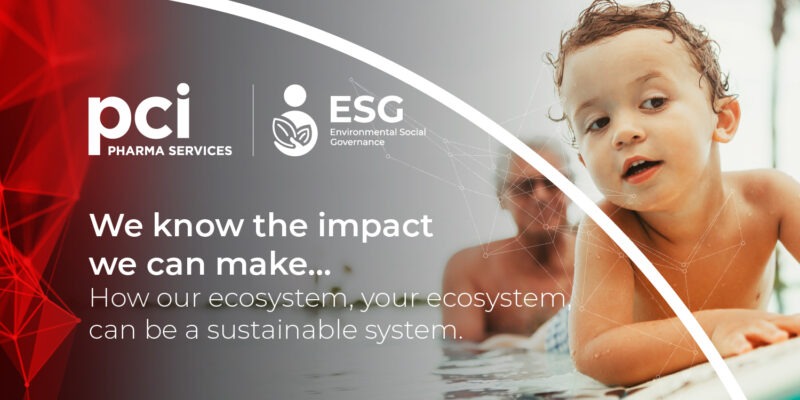A Simplistic Approach To Building a Sustainable Pharmaceutical Supply Chain
Setting the Stage
Operating within strict regulations, the pharmaceutical industry faces unique challenges in the realm of Environmental, Social and Governance (ESG). A prominent consequence of COVID-19 was the scarcity of raw materials, leading to the need for sourcing smaller batches of ingredients from distant locations. This shift negatively affects the environment in terms of transportation and carbon footprint. Moreover, the industry is under increased pressure to expedite the introduction of drugs to the market, resulting in less time devoted to formulation. This could put the shelf stability of new medicines at risk, increasing the burden on packaging materials to achieve higher protective properties, be it for moisture, light, or degradant gases, such as oxygen, etc. These tend to come in conflict with traditional recycling recovery stream infrastructure and guidelines, said Justin Schroeder, PCI Pharma Services’ Global Vice President of Technical Services.
Furthermore, the industry faces the dual pressures of rising product development costs and high inflation, which create a tension between ESG goals and profitability. The evolving standards and regulations surrounding ESG further complicate matters, making it difficult for most pharmaceutical companies to keep up with these demands without a strategic foundation and dedicated resources to meet their goals.
Identifying the Starting Point
While a multi-billion-dollar market cap may make it easier for large companies to create and execute on an ESG plan, any pharmaceutical company willing to put in the work has the same opportunity. Measuring success is key, and from an environmental perspective, you have to be able to gauge what impact you’re having.
A materiality assessment that includes supply-chain mapping helps identify focus areas for an organization. The consulting firm PwC suggests a multi-pronged approach to achieve the best ESG assessment, a method adopted by PCI and encouraged among its client and vendor partners.
To gauge environmental impact and efforts, total energy consumption should be broken down by types of fuel and total refrigerant used within the organization, as well as total fuel consumption from company vehicles. PCI’s assessment and annual sustainability report also tracks water usage, Scope 1, Scope 2, and Scope 3 carbon dioxide emissions, wastewater discharge, waste, and hazardous materials released into the environment.
Adhering to these guidelines allows a company to monitor its entire manufacturing supply chain, track sourcing methods of active pharmaceutical ingredients, examine energy providers and use along the entire supply chain, and hone in on every step from research to shipping. Keep in mind, this also includes employee use of electricity, resources and transportation, as well as the company’s packaging, recycling and waste generation.
Initiating Change
Once an organization has established its baseline ESG levels, it can begin implementing small changes that have the potential to accumulate quickly. Often, there are readily achievable targets that can be addressed promptly.
One large pharmaceutical company committed to achieving net-zero climate emissions by 2040 is actively pursuing a variety of simple and swift processes and initiatives. This company proudly announced the successful elimination of 17 types of single-use plastics across 132 US-based workplaces. This was accomplished by replacing single-use plastic bottles in vending machines with recyclable aluminum, glass, or biodegradable containers. The company also targeted its vendors as another accessible opportunity for improvement. By updating its supplier criteria in September 2021, the company aims to reduce its overall carbon footprint. Through specific ESG goals, such as reducing Scope 3 emissions, it seeks to decrease its total emissions output. Ann Cartwright, PCI’s GSC and Sourcing Systems Strategy Director, affirms that PCI Pharma Services shares similar commitments in selecting vendor partners to achieve its ESG objectives. This approach also benefits PCI’s clients by enabling significant progress.
PCI is already assisting some clients in implementing ESG pilot programs, which have yielded positive outcomes. PCI’s customers can leverage the company for exploratory joint development projects and unique collaborations to test the waters and see if those changes work for them, potentially using those iterations as a spark for a broader change. We ensure during our supply-chain management process that we have a deeper understanding of more about what our suppliers do and their supply chains much more than we ever have in the past. We are asking questions and exploring what’s out there.
Through this, PCI has suggested putting a vetting process in place to make sure company and partner visions align. This is especially useful when executing material selection, local manufacturers, packagers and shipping companies, she added.
Summary
Reducing carbon footprints is a pressing challenge faced by companies worldwide, with pharmaceutical companies encountering additional obstacles due to regulatory constraints and a lack of cohesive ESG strategies. Nevertheless, overcoming these challenges is feasible.
Collaboration with partners and customers is key for companies to achieve the best results in making tangible changes. Engaging external consultants can also provide valuable assistance in identifying opportunities for improving ESG efforts and implementing them effectively. While it is possible to make changes without external collaboration, the potential scope of impact significantly expands when working together.
Internally, companies should establish dedicated ESG teams that focus on projects with measurable outcomes. This can include implementing energy-saving lighting, utilizing motion sensors and water-saving features, as suggested by Gigi Bat-Erdene, Global ESG Program Manager at PCI Pharma Services. Transitioning to fuel sources with smaller carbon footprints and collaborating with transportation and logistics partners helps optimize product transportation globally. Companies can also liaise with local municipalities to obtain clear and consistent recycling guidelines.
Encouragingly, the pharmaceutical industry is actively embracing the necessary changes and developing solutions that yield immediate positive impacts.



